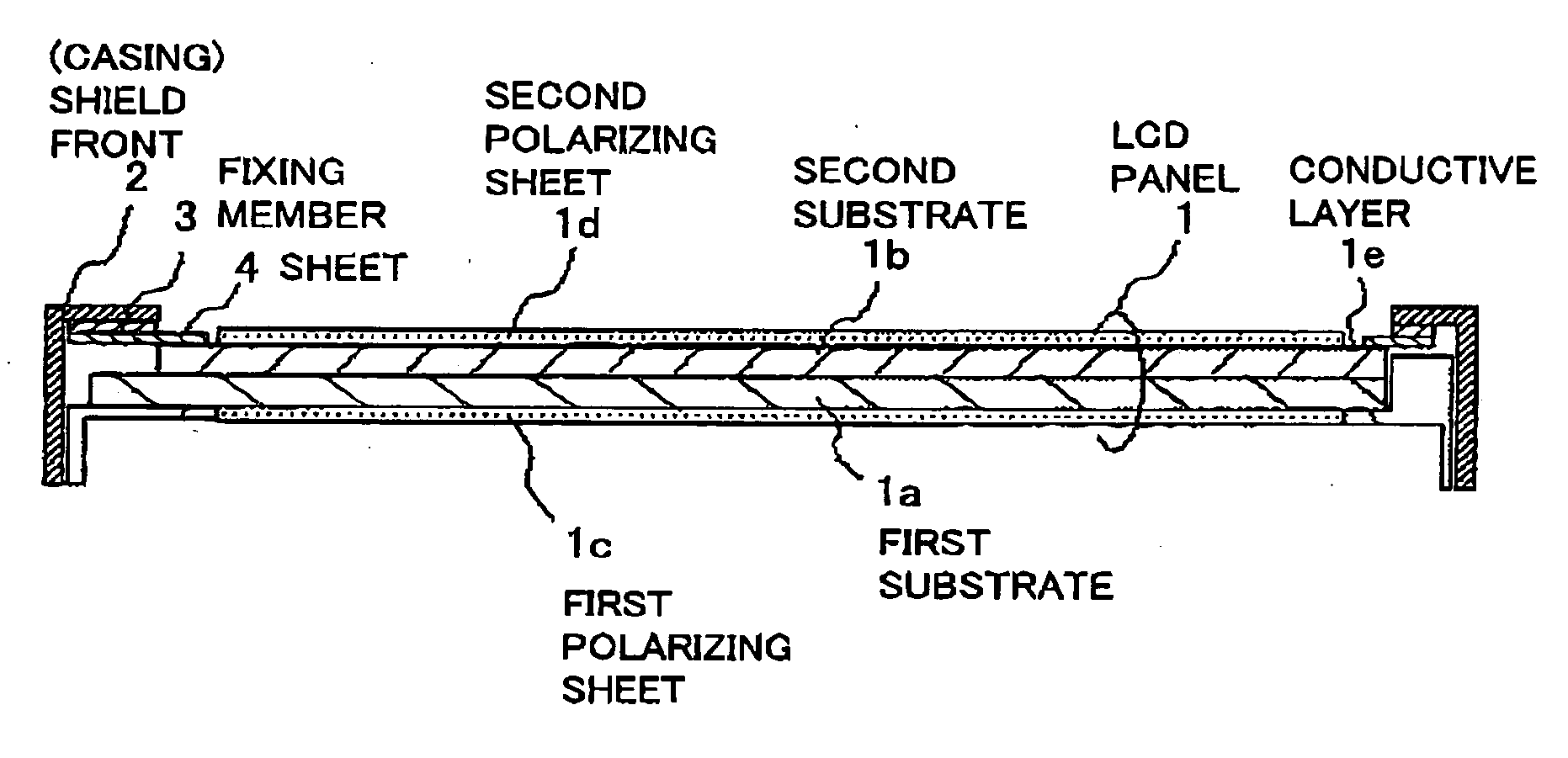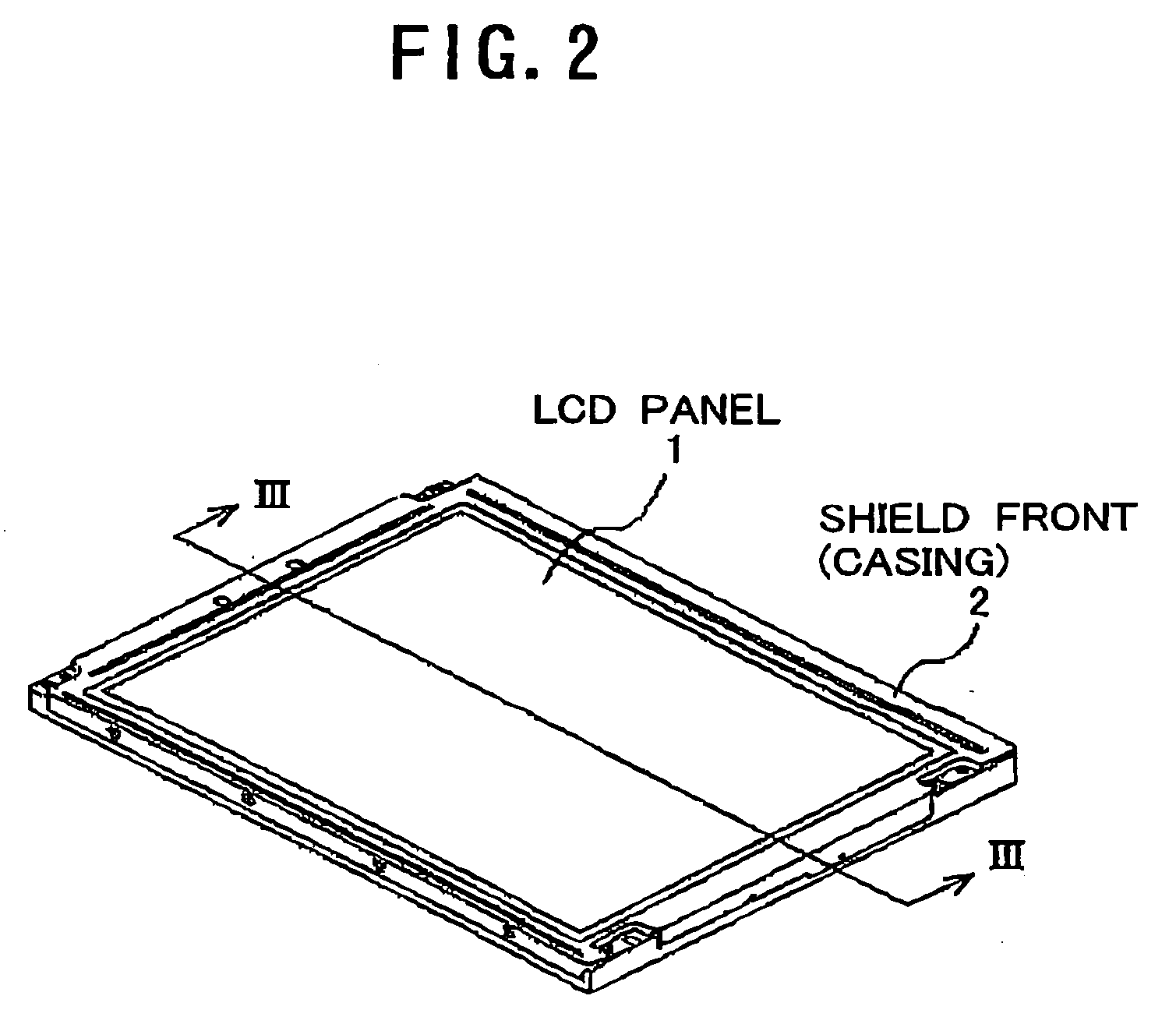Liquid-crystal display device
a liquid crystal display and display device technology, applied in the field of liquid crystal display devices, can solve the problems of disturbing the control of light, affecting and the device is likely to be seen white, so as to reduce the processing accuracy of the casing, suppress the degradation of display quality due to mechanical strain of the lcd panel, and reduce the effect of the flatness of the casing
- Summary
- Abstract
- Description
- Claims
- Application Information
AI Technical Summary
Benefits of technology
Problems solved by technology
Method used
Image
Examples
first embodiment
[0050] An LCD device according to a first embodiment of the invention will be explained with reference to FIGS. 2 to 4. FIG. 2 shows the whole structure of the device, FIG. 3 shows the detailed structure thereof, and FIGS. 4A to 4C and FIGS. 8A and 8B show variations of a sheet having electrical conductivity and a light-blocking property used in this device.
[0051] As shown in FIG. 2, the LCD device according to the first embodiment comprises as its main components an LCD panel 1, a backlight unit (not shown) for generating backlight illuminating the panel 1, and a casing or shield front 2 for receiving the panel 1. As shown in FIG. 3, the panel 1 comprises a first transparent substrate 1a, a second transparent substrate 1b, optical members fixed on the surface of the first substrate 1a, and optical members fixed on the surface of the second substrate 1b. An electrically conductive layer 1e, which is made of Indium Tin Oxide (ITO) or the like, is formed on the surface of the second ...
second embodiment
[0072] Next, an LCD device according to a second embodiment of the invention will be explained with reference to FIG. 5.
[0073] With the LCD device according to the above-described first embodiment, the shield front or casing 2 and the sheet 4 are electrically connected to each other with the conductive fixing member 3, as shown in FIG. 3. However, this structure may be modified as shown in FIG. 5.
[0074] In FIG. 5, the sheet 4 is fixed to the inner surface of the frame-like portion of the front 2 with the fixing member 3, like the first embodiment. However, unlike this, the outer end portion of the sheet 4 is bent toward the front 2, thereby directly contacting the sheet 4 with the front 2. In this case, electrical conductivity is not required for the member 3 and therefore, the selection range of material for the member 3 is expanded. As a result, there is an additional advantage that the fixing strength of the member 3 is increased and the usable temperature range is improved.
third embodiment
[0075]FIG. 6 shows an LCD device according to a third embodiment of the invention.
[0076] With the LCD device according to the above-described first embodiment, the sheet 4 is flat, as shown in FIG. 3. However, the shape of the sheet 4 may be modified as shown in FIG. 6.
[0077] Since the window of the front 2 is greater than the outer dimension of the second substrate 1b, there is no possibility that the front 2 contacts the panel 1, even if the distance between the front 2 and the panel 1 is reduced. Therefore, in this embodiment, the sheet 4 has a cross-section with two bends to form a stepwise structure, as shown in FIG. 6. When the LCD device is placed in such a way that the window of the front 2 is located at a top position, a first part of the sheet 4 on the frame-like portion of the front 2 is lower than a second part of the sheet 4 on the outer portion of the second substrate 1b. The inner surface of the frame-like portion of the front 2 is approximately equal to or lower th...
PUM
 Login to View More
Login to View More Abstract
Description
Claims
Application Information
 Login to View More
Login to View More - R&D
- Intellectual Property
- Life Sciences
- Materials
- Tech Scout
- Unparalleled Data Quality
- Higher Quality Content
- 60% Fewer Hallucinations
Browse by: Latest US Patents, China's latest patents, Technical Efficacy Thesaurus, Application Domain, Technology Topic, Popular Technical Reports.
© 2025 PatSnap. All rights reserved.Legal|Privacy policy|Modern Slavery Act Transparency Statement|Sitemap|About US| Contact US: help@patsnap.com



